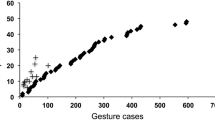Abstract
We introduced a new technique to investigate the development of scribbling in very young infants. We tested three infant chimpanzees to compare the developmental processes of scribbling between humans and chimpanzees. While human infants start to scribble on paper at around the age of 18 months, our 13- to 23-month-old infant chimpanzees had never been observed scribbling prior to this study. We used a notebook computer with a touch-sensitive screen. This apparatus was able to record the location of the subjects’ touches on the screen. Each touch generated a fingertip-sized dot at the corresponding on-screen location. During spontaneous interactions with this apparatus, all three infants and two mother chimpanzees left scribbles with their fingers on the screen. The scribbles contained not only simple dots or short lines, but also curves and hook-like lines or loops, most of which were observed in the instrumental drawings of adult chimpanzees. The results suggest that perceptual-motor control for finger drawing develops in infant chimpanzees. Two of the infants performed their first scribble with a marker on paper at the age of 20–23 months. Just prior to this, they showed a rapid increase in combinatory manipulation of objects. These findings suggest that the development of combinatory manipulation of objects as well as that of perceptual-motor control may be necessary for the emergence of instrumental drawing on paper.






Similar content being viewed by others
References
Adi-Japha E, Levin I, Solomon S (1998) Emergence of representation in drawing: the relation between kinematic and referential aspects. Cogn Dev 14:25–51
Boysen ST, Bernston GG, Prentice J (1987) Simian scribbles: a reappraisal of drawing in the chimpanzee (Pan troglodytes). J Comp Psychol 101:82–89
Cox MV (1992) Children’s drawings. Penguin, London
Gardner H (1980) Artful scribbles: the significance of children’s drawings. Norman, London
Hayashi M, Matsuzawa T (2003) Cognitive development in object manipulation by infant chimpanzees. Anim Cogn 6 (in press). DOI 10.1007/s10071-003-0185-8
Hirata S, Celli ML (2003) Role of mothers in the acquisition of tool use behaviours by captive infant chimpanzees. Anim Cogn 6 (in press). DOI 10.1007/s10071-003-0187-6
Inoue-Nakamura N, Matsuzawa T (1997) Development of stone tool use by wild chimpanzees (Pan troglodytes). J Comp Psychol 111:159–173
Iversen IH, Matsuzawa T (1996) Visually guided drawing in the chimpanzee (Pan troglodytes). Jpn Psychol Res 38:126–135
Iversen IH, Matsuzawa T (1997) Model-guided drawing in the chimpanzee (Pan troglodytes). Jpn Psychol Res 39:154–181
Iversen IH, Matsuzawa T (2001) Establishing line tracing on a touch monitor as a basic drawing skill in chimpanzees (Pan troglodytes). In: Matsuzawa T (ed) Primate origins of human cognition and behavior. Springer, Tokyo Berlin Heidelberg, pp 235–268
Kawai N, Matsuzawa T (2000) Numerical memory span in a chimpanzee. Nature 403:39–40
Kellogg R (1969) Analyzing children’s art. National Press Books, Palo Alto, Calif.
Ladygina-Kots NN (1935) Infant chimpanzee and human child. Museum Darwinianum, Moscow. In: Waal FBM de (ed) (2002) Infant chimpanzee and human child: a classic 1935 comparative study of ape emotion and intelligence. Oxford University Press, New York
Matsuzawa T (ed) (2001) Primate origins of human cognition and behavior. Springer, Tokyo Berlin Heidelberg
Matsuzawa T (2002) Chimpanzee Ai and her son Ayumu: an episode of education by master–apprenticeship. In: Bekoff M, Allen C Burghardt G (eds) The cognitive animal. MIT Press, Cambridge, Mass.
Morris D (1962) The biology of art. Methuen, London
Ochiai T, Matsuzawa T (1998) Planting trees in an outdoor compound of chimpanzees for an enriched environment. In: Hare VJ, Worley E (eds) Proceedings of the Third International Conference on Environmental Enrichment. The shape of enrichment. San Diego, Calif., pp 355–364
Okamoto S, Tomonaga M, Ishii K, Kawai N, Tanaka M, Matsuzawa T (2002) An infant chimpanzee (Pan troglodytes) follows human gaze. Anim Cogn 5:107–114
Schiller P (1951) Figural preferences in the drawings of a chimpanzee. J Comp Physiol Psychol 44:101–111
Smith DA (1973) Systematic study of chimpanzee drawing. J Comp Physiol Psychol 82:406–414
Takeshita H (2001) Development of combinatory manipulation in chimpanzee infants (Pan troglodytes). Anim Cogn 4:335–345
Tanaka M (2001) Discrimination and categorization of photographs of natural objects by chimpanzees (Pan troglodytes ). Anim Cogn 4:201–211
Tomonaga M, Matsuzawa T (2002) Enumeration of briefly presented items by the chimpanzee (Pan troglodytes) and humans (Homo sapiens). Anim Learn Behav 30:143–157
Acknowledgements
This study was partly supported by the MEXT Grants-in-Aid for Scientific Research, Nos. 12002009, 12301006, 10CE2005, and for the 21st Century COE Program (A2 to Kyoto University). We wish to thank Drs. I. H. Iversen and D. Biro for their reading of and comments on an early draft, Mr. S. Nagumo for his technical help in programming and interfacing, and the laboratory staff for their assistance. We also thank the staff members of the Center for Human Evolution Modeling Research, Primate Research Institute, Kyoto University for the management of the subjects’ health.
Author information
Authors and Affiliations
Corresponding author
Rights and permissions
About this article
Cite this article
Tanaka, M., Tomonaga, M. & Matsuzawa, T. Finger drawing by infant chimpanzees (Pan troglodytes). Anim Cogn 6, 245–251 (2003). https://doi.org/10.1007/s10071-003-0198-3
Received:
Revised:
Accepted:
Published:
Issue Date:
DOI: https://doi.org/10.1007/s10071-003-0198-3




